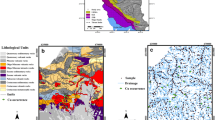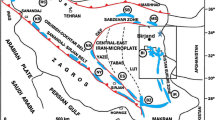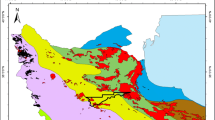Abstract
In this paper, sequential Gaussian simulation (SGS) and number–size (N–S) fractal modeling were used for copper geochemical anomaly mapping in the western part (training area) of Kuhsiah-e-Urmak area, Iran. Then, according to the generated anomaly model in the training area, mineral potential mapping (MPM) was performed for the entire study area based on a well-fitted regression model as a data-driven method. In order to select the best model, six multivariate regression models including two linear, two quadratic, and two cubic functions were examined. For developing a mineral potential map of the study area, the geochemical anomaly raster map of the training area was utilized to create six models based on the values of geo-data sets. According to the results of \(R^{2}\),\(R_{\text{adj}}^{2}\), and \({\text{EF}}\), the fourth model, generated using a quadratic function, was found to be the superior model compared with the rest of regression models defined in this paper. Based on the mathematical formula derived for the superior model, the geo-exploration data sets were synthesized to generate a potential map showing favorable areas for prospecting copper. The potential map generated was verified by the results of lithogeochemical sampling conducted in the training area and field observations in the entire study area.
























Similar content being viewed by others
References
Abedi, M., Mohammadi, R., Norouzi, G. H., & Mohammadi, M. S. M. (2016). A comprehensive VIKOR method for integration of various exploratory data in mineral potential mapping. Arabian Journal of Geosciences,9, 482.
Abedi, M., & Norouzi, G. H. (2012). Integration of various geophysical data with geological and geochemical data to determine additional drilling for copper exploration. Journal of Applied Geophysics,83, 35–45.
Abedi, M., & Norouzi, G. H. (2016). A general framework of TOPSIS method for integration of airborne geophysics, satellite imagery, geochemical and geological data. International Journal of Applied Earth Observation and Geoinformation,46, 31–44.
Abedi, M., Norouzi, G. H., & Bahroudi, A. (2012). Support vector machine for multi-classification of mineral prospectivity areas. Computers & Geosciences,46, 272–283.
Abildin, Y., Madani, N., & Topal, E. (2019). A hybrid approach for joint simulation of geometallurgical variables with inequality constraint. Minerals,9(1), 24.
Afzal, P., Alghalandis, Y. F., Khakzad, A., Moarefvand, P., & Omran, N. R. (2011). Delineation of mineralization zones in porphyry Cu deposits by fractal concentration–volume modeling. Journal of Geochemical Exploration,108, 220–232.
Agterberg, F. P., Cheng, Q., Brown, A., & Good, D. (1996). Multifractal modeling of fractures in the Lac du Bonnet batholith, Manitoba. Computers & Geosciences,22, 497–507.
Alavi, M. (2004). Regional stratigraphy of the Zagros fold-thrust belt of Iran and its proforeland evolution. American Journal of Science,304, 1–20.
Allbed, A., Kumar, L., & Sinha, P. (2014). Mapping and modelling spatial variation in soil salinity in the Al Hassa Oasis based on remote sensing indicators and regression techniques. Remote Sensing,6, 1137–1157.
Asadi, H. H., Porwal, A., Fatehi, M., Kianpouryan, S., & Lu, Y. J. (2015). Exploration feature selection applied to hybrid data integration modeling: Targeting copper-gold potential in central Iran. Ore Geology Reviews,71, 819–838.
Asghari, O., Soltni, F., & Hassan, B. A. (2009). The comparison between sequential gaussian simulation (SGS) of Choghart ore deposit and geostatistical estimation through ordinary kriging. Australian Journal of Basic Applied Sciences,3, 330–341.
Baber, K., Otto, P., Kahl, T., Gossner, M. M., Wirth, C., Gminder, A., et al. (2016). Disentangling the effects of forest-stand type and dead-wood origin of the early successional stage on the diversity of wood-inhabiting fungi. Forest Ecology and Management,377, 161–169.
Bølviken, B., Stokke, P. R., Feder, J., & Jössang, T. (1992). The fractal nature of geochemical landscapes. Journal of Geochemical Exploration,43, 91–109.
Bonham-Carter, G. F. (1994). Geographic information systems for geoscientists: Modeling with GIS (p. 398). Oxford: Pergamon Press.
Bring, J. (1994). How to standardize regression coefficients. The American Statistician,48, 209–213.
Bring, J. (1996). A geometric approach to compare variables in a regression model. The American Statistician,50, 57–62.
Burrough, P. A., & McDonnell, R. A. (1998). Principles of geographical information systems. Oxford: Oxford University Press.
Carranza, E. J. M. (2008). Geochemical anomaly and mineral prospectivity mapping in GIS, Handbook of Exploration Environmental Geochemistry (p. 368). Amsterdam: Elsevier.
Carranza, E. J. M., & Hale, M. (2001a). Geologically constrained fuzzy mapping of gold mineralization potential, Baguio district, Philippines. Natural Resources Research,10, 125–136.
Carranza, E. J. M., & Hale, M. (2001b). Logistic regression for geologically constrained mapping of gold potential, Baguio district, Philippines. Exploration and Mining Geology,10, 165–175.
Carranza, E. J. M., & Hale, M. (2002). Spatial association of mineral occurrences and curvilinear geological features. Mathematical Geology,34(2), 203–221.
Carranza, E. J. M., & Laborte, A. G. (2015). Random forest predictive modeling of mineral prospectivity with small number of prospects and data with missing values in Abra (Philippines). Computers & Geosciences,74, 60–70.
Chen, F., Chen, S., & Peng, G. (2012). Using sequential Gaussian simulation to assess geochemical anomaly areas of lead element. CCTA Spring.,2, 69–76.
Chen, G., & Cheng, Q. (2018). Fractal-based wavelet filter for separating geophysical or geochemical anomalies from background. Mathematical Geosciences,50, 249–272.
Cheng, Q. (1999). Spatial and scaling modelling for geochemical anomaly separation. Journal of Geochemical Exploration,65, 175–194.
Cheng, Q. (2007a). Mapping singularities with stream sediment geochemical data for prediction of undiscovered mineral deposits in Gejiu, Yunnan Province, China. Ore Geology Reviews,32, 314–324.
Cheng, Q. (2007b). Multifractal imaging filtering and decomposition methods in space, Fourier frequency, and eigen domains. Nonlinear Processes in Geophysics,14(3), 293–303.
Cheng, Q., Agterberg, F. P., & Ballantyne, S. B. (1994). The separation of geochemical anomalies from background by fractal methods. Journal of Geochemical Exploration,51, 109–130.
Emery, X., & Lantuéjoul, C. (2006). Tbsim: A computer program for conditional simulation of three-dimensional gaussian random fields via the turning bands method. Computers & Geosciences,32, 1615–1628.
Emery, X., & Robles, L. N. (2009). Simulation of mineral grades with hard and soft conditioning data: application to a porphyry copper deposit. Computational Geosciences,13, 79.
Ersoy, A., & Yunsel, T. Y. (2019). Geochemical modelling and mapping of Cu and Fe anomalies in soil using combining sequential Gaussian co-simulation and local singularity analysis: A case study from Dedeyazı (Malatya) region, SE Turkey. Geochemistry Exploration, Environment, Analysis. https://doi.org/10.1144/geochem2018-083.
Feizi, F., Karbalaei-Ramezanali, A., & Mansouri, E. (2017a). Calcic iron skarn prospectivity mapping based on fuzzy AHP method, a case Study in Varan area, Markazi province, Iran. Geosciences Journal,21, 123–136.
Feizi, F., Karbalaei-Ramezanali, A., & Tusi, H. (2017b). Mineral potential mapping via TOPSIS with hybrid AHP–Shannon entropy weighting of evidence: A case study for porphyry-cu, Farmahin area, Markazi Province, Iran. Natural Resources Research,26(4), 553–570.
Feizi, F., Mansouri, E., & KarbalaeiRamezanali, A. (2016). Prospecting of Au by remote sensing and geochemical data processing using fractal modelling in Shishe-Botagh, Area (NW Iran). Journal of the Indian Society of Remote Sensing,44, 539–552.
Feizi, F., & Mansuri, E. (2013a). Separation of alteration zones on ASTER data and integration with drainage geochemical maps in Soltanieh, Northern Iran. Open Journal of Geology,3, 134.
Feizi, F., & Mansuri, E. (2013b). Introducing the iron potential zones using remote sensing studies in South of Qom Province, Iran. Open Journal of Geology,3, 278–286.
Forkuor, G., Hounkpatin, O. K., Welp, G., & Thiel, M. (2017). High resolution mapping of soil properties using remote sensing variables in south-western Burkina Faso: A comparison of machine learning and multiple linear regression models. PLoS ONE,12(1), e0170478.
Ghorbani, M. (2013). Economic geology of Iran (p. 569). Netherlands: Springer.
Goovaerts, P. (1999). Geostatistics in soil science: State-of-the-art and perspectives. Geoderma,89(1–2), 1–45.
Granian, H., Tabatabaei, S. H., Asadi, H. H., & Carranza, E. J. M. (2015). Multivariate regression analysis of lithogeochemical data to model subsurface mineralization: A case study from the Sari Gunay epithermal gold deposit, NW Iran. Journal of Geochemical Exploration,148, 249–258.
Greenland, S., Schlesselman, J. J., & Criqui, M. H. (1987). Re: “The fallacy of employing standardized regression coefficients and correlations as measures of effect”. American Journal of Epidemiology,125, 349–350.
Harris, D., & Pan, G. (1999). Mineral favorability mapping: A comparison of artificial neural networks, logistic regression, and discriminant analysis. Natural Resources Research,8, 93–109.
Harris, D., Zurcher, L., Stanley, M., Marlow, J., & Pan, G. (2003). A comparative analysis of favorability mappings by weights of evidence, probabilistic neural networks, discriminant analysis, and logistic regression. Natural Resources Research,12, 241–255.
He, J. Z., Yao, S. Z., Zhang, Z. P., & You, G. J. (2013). Complexity and productivity differentiation models of metallogenic indicator elements in rocks and supergene media around Daijiazhuang Pb–Zn deposit in Dangchang County, Gansu Province. Natural Resources Research,22, 19–36.
Hendra, H., & Kaihatu, T. S. (2019). How does the store (mall) environment and money availability affect consumer impulse buying behavior at Surabaya city of tomorrow shopping center? Jurnal Riset Manajemen dan Bisnis (JRMB),4(2), 215–224.
Hezarkhani, A. (2006). Hydrothermal evolution of the Sar-Cheshmeh porphyry Cu–Mo deposit, Iran: Evidence from fluid inclusions. Journal of Asian Earth Sciences,28, 409–422.
Honarmand, M., Rashidnejad Omran, N., Neubauer, F., Hashem Emami, M., Nabatian, G., Liu, X., et al. (2014). Laser-ICP-MS U-Pb zircon ages and geochemical and Sr–Nd–Pb isotopic compositions of the Niyasar plutonic complex, Iran: Constraints on petrogenesis and tectonic evolution. International Geology Review,56, 104–132.
King, G. (1986). How not to lie with statistics: Avoiding common mistakes in quantitative political science. American Journal of Political Science,30(3), 666–687.
Kruskal, W., & Majors, R. (1989). Concepts of relative importance in recent scientific literature. The American Statistician,43, 2–6.
Lark, R., Patton, M., Ander, E., & Reay, D. (2018). The singularity index for soil geochemical variables, and a mixture model for its interpretation. Geoderma,323, 83–106.
Li, C., Ma, T., & Shi, J. (2003). Application of a fractal method relating concentrations and distances for separation of geochemical anomalies from background. Journal of Geochemical Exploration,77, 167–175.
Lima, A., De Vivo, B., Cicchella, D., Cortini, M., & Albanese, S. (2003). Multifractal IDW interpolation and fractal filtering method in environmental studies: An application on regional stream sediments of (Italy), Campania region. Applied Geochemistry,18, 1853–1865.
Liu, Y., Cheng, Q., Carranza, E. J. M., & Zhou, K. (2019a). Assessment of geochemical anomaly uncertainty through geostatistical simulation and singularity analysis. Natural Resources Research,28, 199–212.
Liu, Y., Cheng, Q., & Zhou, K. (2019b). New insights into element distribution patterns in geochemistry: A perspective from fractal density. Natural Resources Research,28, 5–29.
Liu, Y., Xia, Q., & Carranza, E. J. M. (2019c). Integrating sequential indicator simulation and singularity analysis to analyze uncertainty of geochemical anomaly for exploration targeting of tungsten polymetallic mineralization, Nanling belt, South China. Journal of Geochemical Exploration,197, 143–158.
Luz, F., Mateus, A., Matos, J. X., & Gonçalves, M. A. (2014). Cu-and Zn-soil anomalies in the NE border of the south Portuguese zone (Iberian Variscides, Portugal) identified by multifractal and geostatistical analysis. Natural Resources Research,23, 195–215.
Madani, N., & Sadeghi, B. (2019). Capturing hidden geochemical anomalies in scarce data by fractal analysis and stochastic modeling. Natural Resources Research, 28(3), 833–847.
Madani, N., Yagiz, S., & Coffi Adoko, A. (2018). Spatial mapping of the rock quality designation using multi-Gaussian Kriging method. Minerals,8(11), 530.
Mandelbrot, B. B. (1983). The fractal geometry of nature (p. 468). San Francisco: Freeman.
Mansouri, E., Feizi, F., & Karbalaei Ramezanali, A. A. (2015). Identification of magnetic anomalies based on ground magnetic data analysis using multifractal modelling: A case study in Qoja-Kandi, East Azerbaijan Province, Iran. Nonlinear Processes in Geophysics,22(5), 579–587.
Mansouri, E., Feizi, F., Rad, A. J., & Arian, M. (2018). Remote-sensing data processing with the multivariate regression analysis method for iron mineral resource potential mapping: A case study in the Sarvian area, central Iran. Solid Earth,9(2), 373.
Matheron, G. (1962). Traité de géostatistique appliquée. 1. Editions Technip.
Matthews, S. A., & Yang, T. C. (2012). Mapping the results of local statistics: Using geographically weighted regression. Demographic research,26, 151.
Niiranen, T., Nykänen, V., & Lahti, I. (2019). Scalability of the mineral prospectivity modelling—An orogenic gold case study from northern Finland. Ore Geology Reviews,109, 11–25.
Nykänen, V., & Salmirinne, H. (2007). Prospectivity analysis of gold using regional geophysical and geochemical data from the Central Lapland Greenstone Belt, Finland. Geological Survey of Finland,44, 251–269.
Ortiz, X. (2006). Geostatistical estimation of mineral resources with soft geological boundaries: A comparative study. Journal of the Southern African Institute of Mining and Metallurgy,106, 577–584.
Paravarzar, S., Emery, X., & Madani, N. (2015). Comparing sequential Gaussian and turning bands algorithms for cosimulating grades in multi-element deposits. Comptes Rendus Geoscience,347, 84–93.
Parsa, M., & Maghsoudi, A. (2018). Controls on Mississippi Valley-Type Zn–Pb mineralization in Behabad district, Central Iran: Constraints from spatial and numerical analyses. Journal of African Earth Sciences,140, 189–198.
Parsa, M., Maghsoudi, A., Carranza, E. J. M., & Yousefi, M. (2017a). Enhancement and mapping of weak multivariate stream sediment geochemical anomalies in Ahar Area, NW Iran. Natural Resources Research,26, 443–455.
Parsa, M., Maghsoudi, A., & Ghezelbash, R. (2016). Decomposition of anomaly patterns of multi-element geochemical signatures in Ahar area, NW Iran: A comparison of U-spatial statistics and fractal models. Arabian Journal of Geosciences,9, 260.
Parsa, M., Maghsoudi, A., & Yousefi, M. (2018). Spatial analyses of exploration evidence data to model skarn-type copper prospectivity in the Varzaghan district, NW Iran. Ore Geology Reviews,92, 97–112.
Parsa, M., Maghsoudi, A., Yousefi, M., & Carranza, E. J. M. (2017b). Multifractal interpolation and spectrum–area fractal modeling of stream sediment geochemical data: Implications for mapping exploration targets. Journal of African Earth Sciences,128, 5–15.
Parsa, M., Maghsoudi, A., Yousefi, M., & Sadeghi, M. (2017c). Multifractal analysis of stream sediment geochemical data: Implications for hydrothermal nickel prospection in an arid terrain, eastern Iran. Journal of Geochemical Exploration,181, 305–317.
Porwal, A., Carranza, E. J. M., & Hale, M. (2004). A hybrid neuro-fuzzy model for mineral potential mapping. Mathematical Geology,36, 803–826.
Porwal, A., Carranza, E. J. M., & Hale, M. (2006). A hybrid fuzzy weights-of-evidence model for mineral potential mapping. Natural Resources Research,15, 1–14.
Ripley, B. D. (1984). Spatial statistics: Developments 1980-3, correspondent paper. International Statistical Review/Revue Internationale de Statistique,52(2), 141–150.
Sadeghi, B., Madani, N., & Carranza, E. J. M. (2014). Combination of geostatistical simulation and fractal modeling for mineral resource classification. Journal of Geochemical Exploration,149, 59–73.
Shepard, D. (1968). A two-dimensional interpolation function for irregularly-spaced data. In Proceedings of the 1968 23rd ACM national conference (pp. 517–524). ACM.
Shinozuka, M., & Jan, C. M. (1972). Digital simulation of random processes and its applications. Journal of Sound and Vibration,25, 111–128.
Tennant, C. B., & White, M. L. (1959). Study of the distribution of some geochemical data. Economic Geology,54, 1281–1290.
Thamma, R. (2008). Comparison between multiple regression models to study effect of turning parameters on the surface roughness. In Proceedings of the 2008 IAJC-IJME international conference (Vol. 133, no. 103, pp. 1–12).
Wang, J., & Zuo, R. (2018). Identification of geochemical anomalies through combined sequential Gaussian simulation and grid-based local singularity analysis. Computers & Geosciences,118, 52–64.
Wang, J., & Zuo, R. (2019). Recognizing geochemical anomalies via stochastic simulation-based local singularity analysis. Journal of Geochemical Exploration,198, 29–40.
Zuo, R. (2011). Identifying geochemical anomalies associated with Cu and Pb–Zn skarn mineralization using principal component analysis and spectrum–area fractal modeling in the Gangdese Belt, Tibet (China). Journal of Geochemical Exploration,111, 13–22.
Zuo, R. (2016). A nonlinear controlling function of geological features on magmatic-hydrothermal mineralization. Scientific Reports,6, 27127.
Zuo, R. (2017). Machine learning of mineralization-related geochemical anomalies: A review of potential methods. Natural Resources Research,26, 457–464.
Zuo, R. (2018). Selection of an elemental association related to mineralization using spatial analysis. Journal of Geochemical Exploration,184, 150–157.
Zuo, R., & Carranza, E. J. M. (2017). A fractal measure of spatial association between landslides and conditioning factors. Journal of Earth Science,28, 588–594.
Zuo, R., & Cheng, Q. (2008). Mapping singularities—a technique to identify potential Cu mineral deposits using sediment geochemical data, an example for Tibet, west China. Mineralogical Magazine,72, 531–534.
Zuo, R., Cheng, Q., Agterberg, F. P., & Xia, Q. (2009a). Application of singularity mapping technique to identify local anomalies using stream sediment geochemical data, a case study from Gangdese, Tibet, western China. Journal of Geochemical Exploration,101, 225–235.
Zuo, R., Cheng, Q., Xia, Q., & Agterberg, F. P. (2009b). Application of fractal models to distinguish between different mineral phases. Mathematical Geosciences,41, 71–80.
Zuo, R., & Wang, J. (2016). Fractal/multifractal modeling of geochemical data: A review. Journal of Geochemical Exploration,164, 33–41.
Zuo, R., Xia, Q., & Wang, H. (2013). Compositional data analysis in the study of integrated geochemical anomalies associated with mineralization. Applied Geochemistry,28, 202–211.
Acknowledgments
The authors would like to thank Dr. Soheil Eyvazkhani for his helpful suggestions, the editor in chief (Prof. Emmanuel John M. Carranza), the associate editor for NRR (Prof. Renguang Zuo), and anonymous reviewers of this paper for their comments and valuable remarks.
Author information
Authors and Affiliations
Corresponding author
Rights and permissions
About this article
Cite this article
Karbalaei Ramezanali, A., Feizi, F., Jafarirad, A. et al. Geochemical Anomaly and Mineral Prospectivity Mapping for Vein-Type Copper Mineralization, Kuhsiah-e-Urmak Area, Iran: Application of Sequential Gaussian Simulation and Multivariate Regression Analysis. Nat Resour Res 29, 41–70 (2020). https://doi.org/10.1007/s11053-019-09565-7
Received:
Accepted:
Published:
Issue Date:
DOI: https://doi.org/10.1007/s11053-019-09565-7




